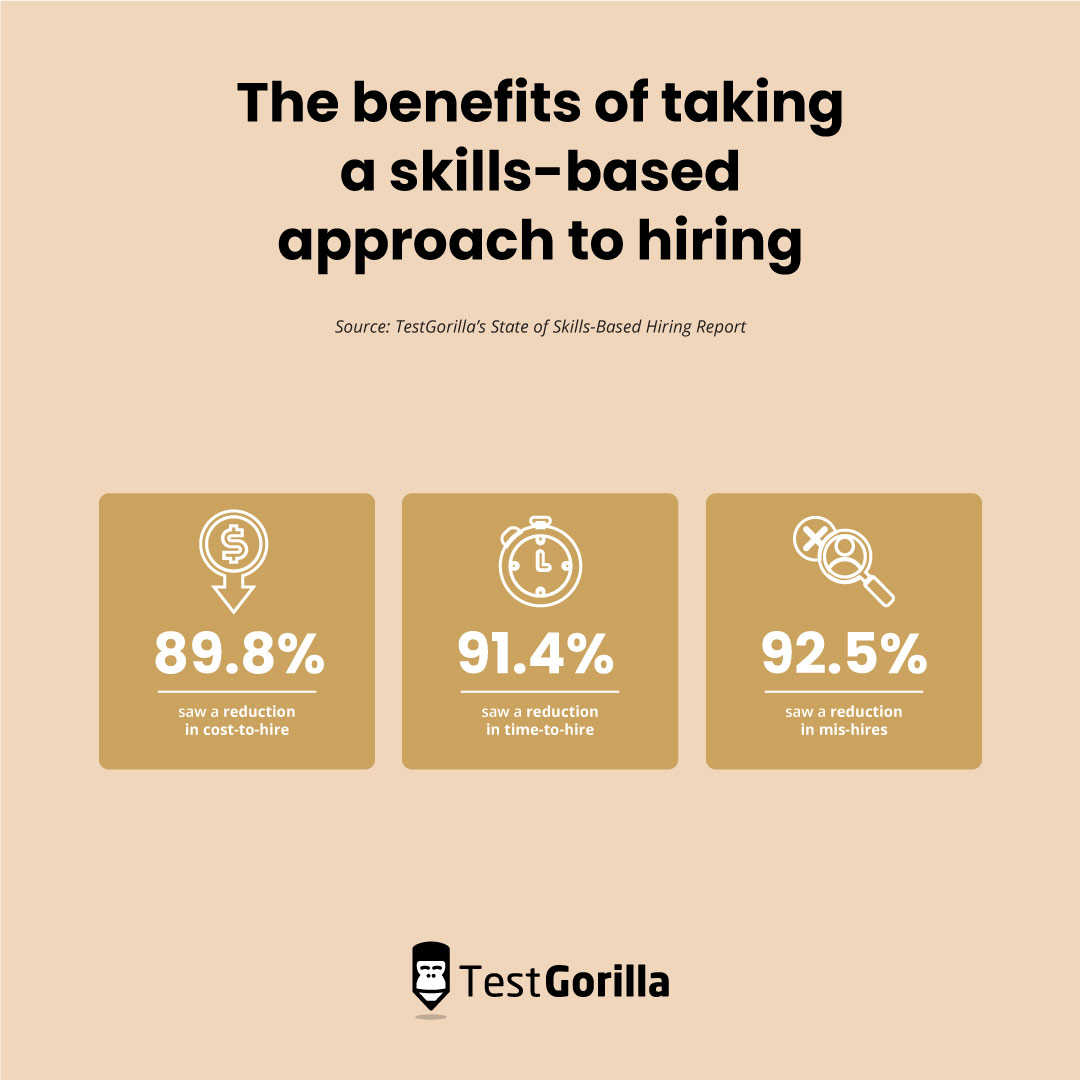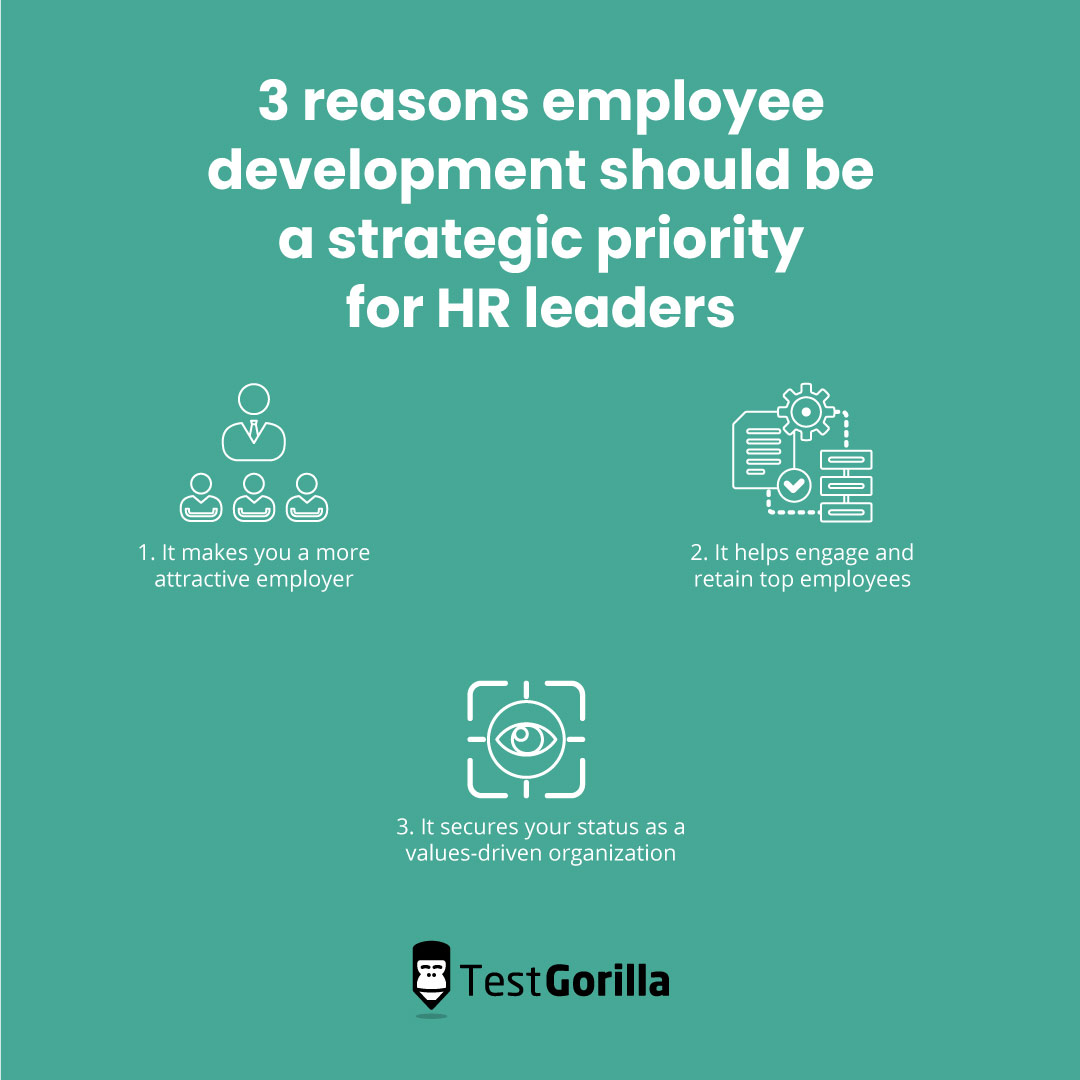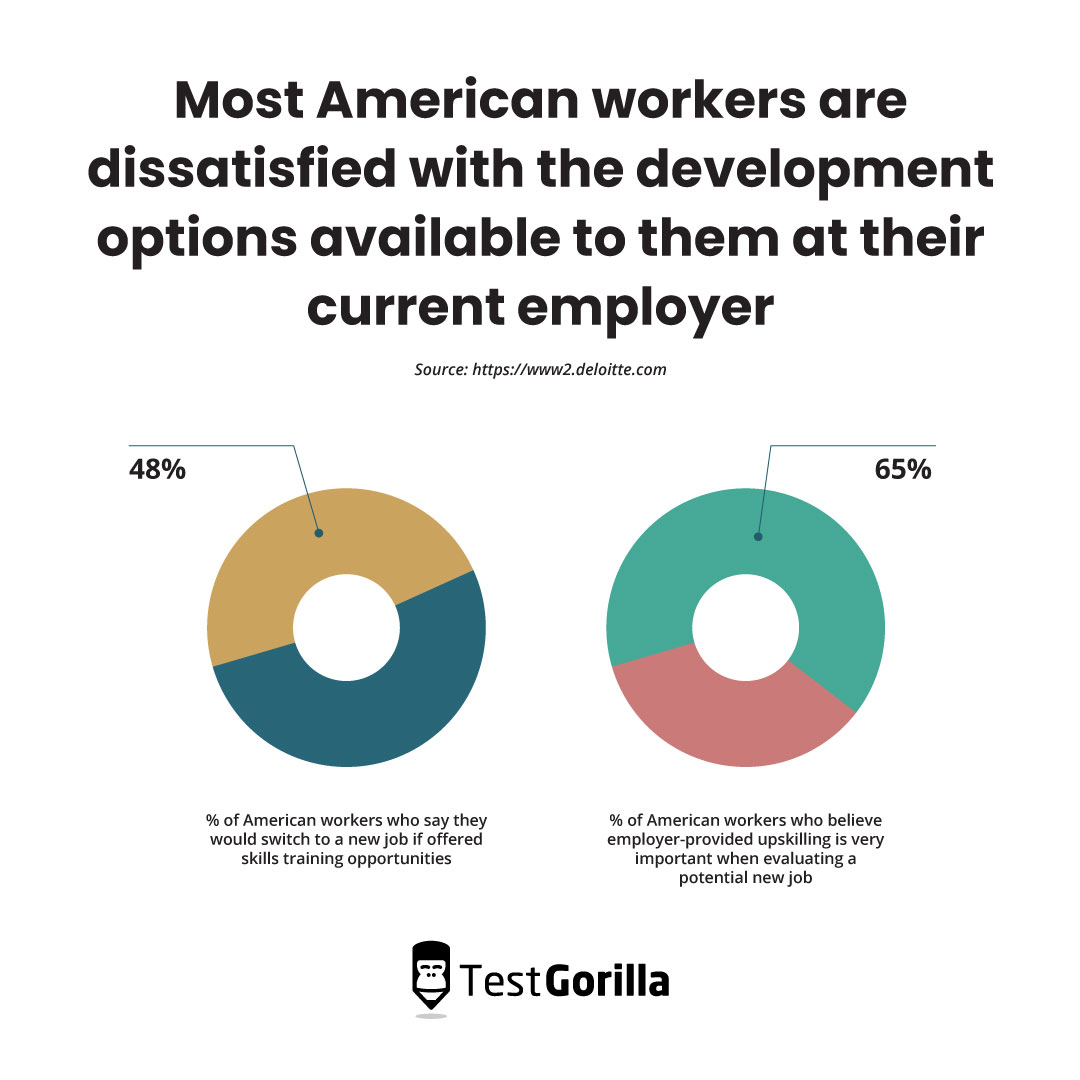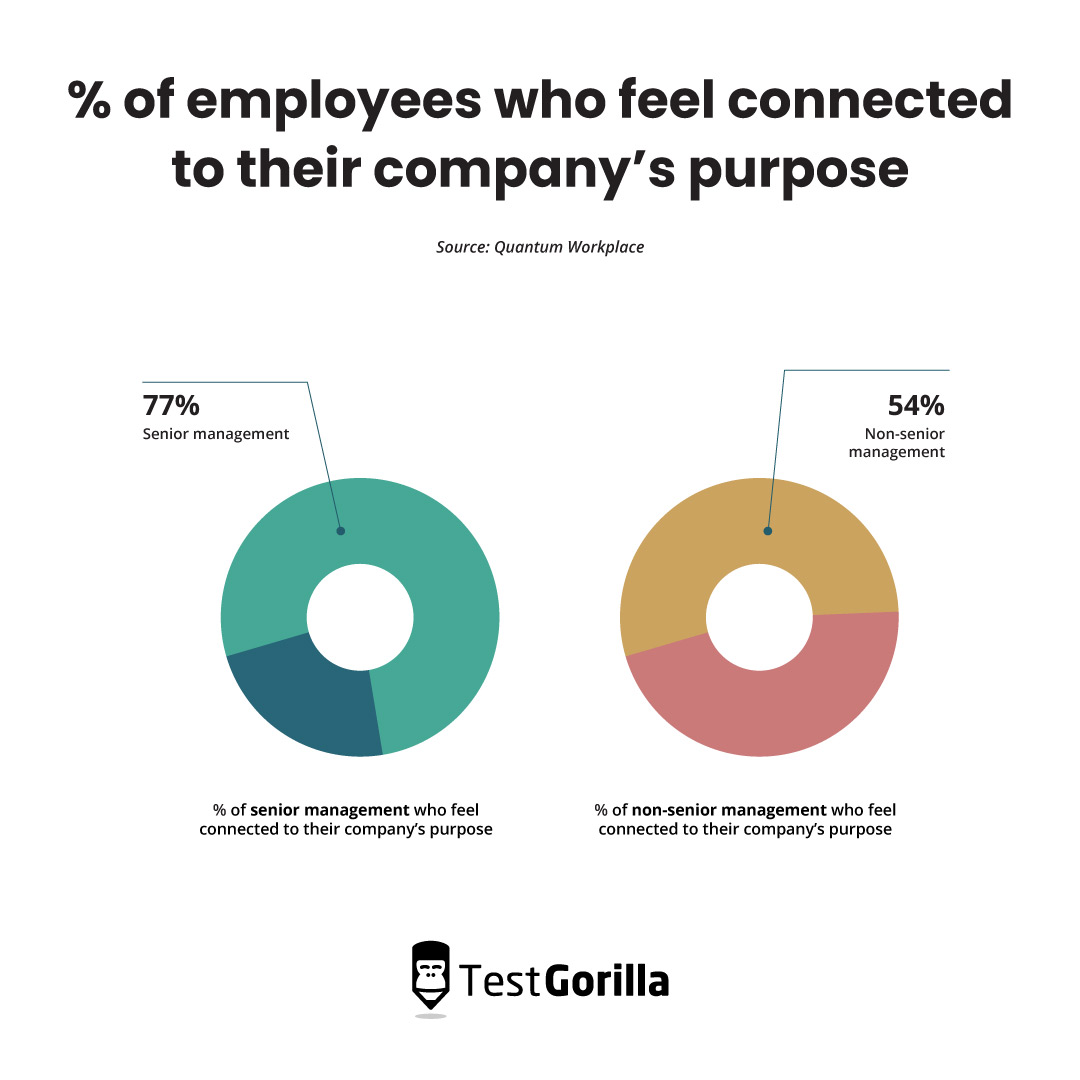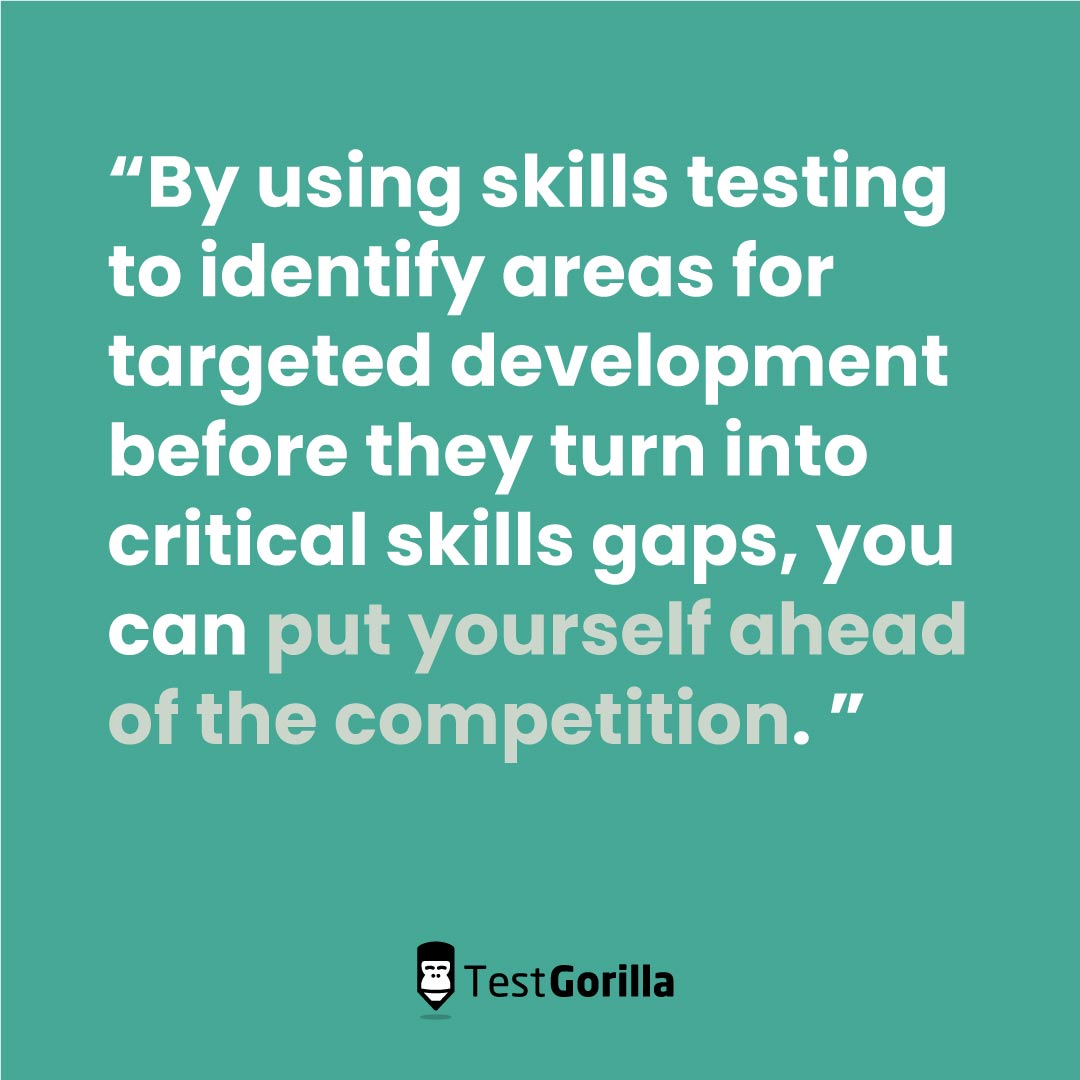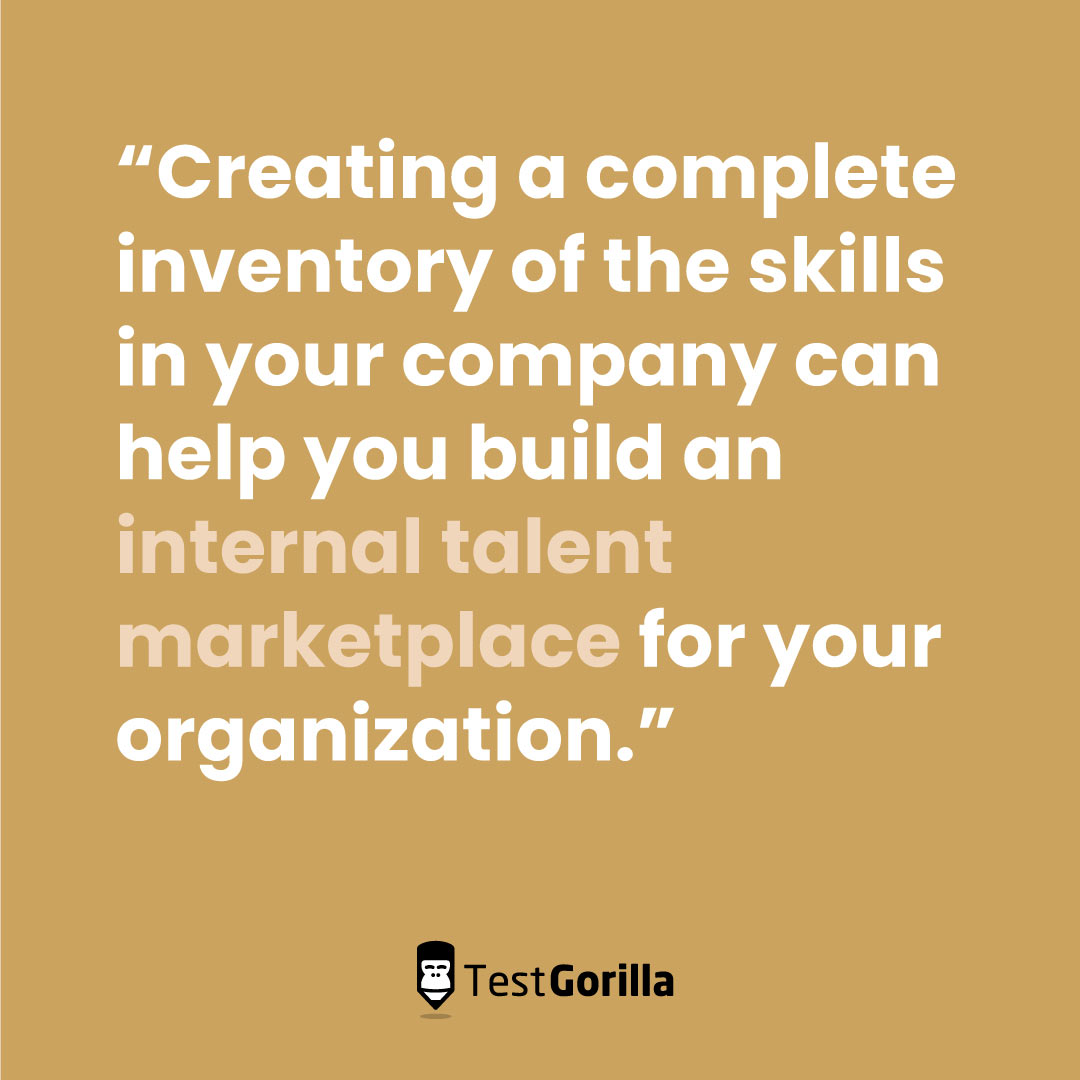Why skills-based hiring and employee development go hand in hand
The benefits of taking a skills-based approach to hiring are well-known at this point – we certainly shout about them enough.
Our research has shown that not only are over three-quarters of employers already using skills-based hiring methods but that:
89.8% saw a reduction in cost-to-hire
91.4% saw a reduction in time-to-hire
92.5% saw a reduction in mis-hires
Clearly, the skills-based approach is the right one for finding motivated candidates to fill open roles. What many leaders neglect is the skills-based method’s potential to revolutionize employee development and retention after hiring.
In this blog, we’ll demonstrate what makes employee development a priority for forward-thinking organizations and how a skills-based approach can supercharge your strategy.
From conducting a skills gap analysis to using upskilling to fill open roles, by the end of this blog, you’ll understand why skills-based hiring methods and employee development go hand in hand.
Let’s get into it.
3 reasons employee development should be a strategic priority for HR leaders
Most leaders recognize the benefits that learning and development initiatives have for their employees. But how do upskilling and other development programs, in addition to being good perks for your workforce, also serve as an essential step in growing your business?
1. It makes you a more attractive employer
Upskilling your employees not only benefits the quality of their work but also improves your employer brand as you gain a reputation for investing in your employees.
This can put your company head and shoulders above your competitors when it comes to attracting new talent. Most American workers are dissatisfied with the development options available to them at their current employer: only 34% currently express satisfaction with their employer’s investment in their skill development.
In fact, the American Upskilling Study found that among American workers that were surveyed, almost half of them said they would switch to a new position if it offered skills training, and 65% believe that employer-provided upskilling is very important when evaluating a potential new job.
2. It helps engage and retain top employees
Employee engagement is in crisis. The percentage of workers in the U.S. who considered themselves “engaged” declined from 36% in the first half of 2021 to just over 33% – the first drop in more than a decade – and 16% of employees admitted to being actively disengaged from their workplace.
Employees everywhere are feeling disillusioned, wondering why they should invest their effort in an organization if that organization is not similarly invested in their growth.
Development initiatives are the antidote to this; they signal to your employees that you really care about their development. In a 2020 LinkedIn Learning survey, workers reported being more likely to stay at a company if they were involved in its learning and development programs.[1]
3. It secures your status as a values-driven organization
Finally, and perhaps most importantly, if you claim to be a “values-driven” organization where teammates “are like family,” upskilling is an opportunity for you to put your money where your mouth is.
Employee development programs show your employees that you are interested in more than just the value they can provide you: you also care about their career progression, regardless of where they fit in the company hierarchy.
This is something many workplaces are missing. One study by Quantum Workplace found that while 77% of senior management feel connected to their company’s purpose, only 54% of the employees working under them say the same.
Carving out a budget and, crucially, company time for employee development (rather than having them use their personal time) shows your employees that you’re invested in them as individuals.
It also gives you the opportunity to provide rewards for hitting development goals and creating a cohesive culture regardless of whether you work together in the same office or are scattered around the world. The Quantum Workplace study cited above also found that 53% of employees experience culture through recognition and celebration of their achievements.
So, why should you use a skills-based approach to implement these development initiatives?
How a skills-based approach can supercharge employee development
By now, we hope it’s clear why employee development should be at the top of your agenda as an HR leader. It’s time to talk about how focusing on skills fits into all this.
Deloitte research has found that skills-based organizations were almost twice as likely to retain high performers and more than twice as likely to achieve innovation, but what about the skills-based method creates these benefits?
Here are the top reasons why it’s so effective.
It gives you a complete overview of the skills in your workforce
In order to effectively prioritize your employee development programs and ensure that employees are getting the training they want and need, you need to understand the skills that are already available in your workforce. Skills-based methods make this easy.
Using skills tests to assess the skills of your employees revolutionizes the way you look at your workforce.
Think about it: while you might have a list of the roles and responsibilities your employees each perform, these could disguise any number of skills that you’re not yet tapping into – almost all of which are transferable to other priorities and positions.
By conducting an audit of the skills in your company with skills testing, you can get an accurate overall picture of the skills available to you within your organization.
This can help you be more agile when adapting to change because it empowers you to assemble cross-functional teams to respond to emerging business challenges much more quickly than traditional methods.
It also enables you to embrace cross-functional teams more widely within your organization. By basing new hires on the skills they can bring to the team rather than solely the positions they’ve held in the past, you can create a team with all the necessary expertise and a variety of work experience.
This is essential when navigating the fluctuations of digital business. Research shows that creating cross-functional teams goes hand in hand with digital maturity, as 73% of digitally maturing companies create the conditions for them to thrive compared to just 48% of developing companies and 29% of early-stage ones.[2]
It helps you identify and fill skills gaps
Of course, the ultimate goal of talent mapping is not only to show you what skills you do have in your workforce but also to highlight the ones you don’t.
87% of companies worldwide either already have a skills gap or expect to experience one in the near future. Conducting a skills gap analysis as part of the talent mapping process can help you identify existing skills gaps and even predict where your next one will be as you compare your current resources to the skills required to hit upcoming targets.
You can also predict skills gaps based on wider industry data. For example, 59% of hiring managers expect technology like artificial intelligence and workplace automation to disrupt the kinds of skills they need from their employees.[3]
According to their predictions, hard skills like data analysis and software development will grow in importance, as will soft skills like collaboration and creative thinking.
By using skills testing to identify areas for targeted development before they turn into critical skills gaps, you can put yourself ahead of the competition. Only 17% of organizations believe they have the capabilities to accurately predict the skills they’ll need in the future, and only 16% plan to invest significantly in learning over the next three years.[4]
It illuminates your employees’ learning styles
As well as providing learning opportunities for employees, conducting a skills audit with assessments also gives you valuable pointers for how best to administer this training.
For example, personality testing can clue you into your employees’ communication styles. This not only helps you identify the best person on their team to give them peer-to-peer training, but it can also help you match them with a mentor further up the company hierarchy.
Tests can also give your employees the self-insight required to direct their own learning. For example, they might not realize until taking a test that they motivate themselves best through teamwork, which primes them to get the most out of live classroom learning.
They might equally discover that their combination of traits suits them best to e-learning in some subjects and live learning in others. For instance, at EY (a hybrid organization), leaders use an intentional combination of on-demand e-learning and virtual live experiences to train employees.
The key is to use your insights into your employees’ personalities from skills testing to tailor the learning programs to their particular needs. This can be done whether your workforce is in-person, hybrid, or fully remote.
It provides metrics for development tracking
No professional development plan is complete without setting clear, measurable goals for progress. The tools associated with a skills-based approach are invaluable here.
Let’s say a junior copywriter has aspirations to become a content strategist. Your talent mapping exercise has already proven that they have a strong base of skills to start from, so you would then ask the employee to complete a self-evaluation alongside further skills tests. These would measure:
Technical skills, such as technical SEO
Soft skills like communication and motivation
Personal traits, like their personality type
You could then use the results of both assessments to craft their development plan. Comparing the two outcomes is key here, as it can help you identify any biases the employee may have that could stall their development.
If they have impostor syndrome, for example, they might underestimate their own proficiency, disempowering them to take initiative and having knock-on effects on their wellbeing. Being aware of this at the outset of their development can help you complement their upskilling plan with appropriate wellbeing initiatives to build their confidence.
Once all this is done, you can use the same skills tests to measure their development, look for a certain level of improvement in their scores on technical tests, or even graduate them from entry-level testing to intermediate after a few months.
At the end of this process you’ll have a clear track record of the employee’s improvement – which, if they do suffer from confidence issues, can be brought up by mentors and managers to reassure them that they are ready for the next step.
Speaking of which…
It highlights opportunities for promotion and redeployment – with less bias
If skills-based hiring methods can help you identify leaders when hiring, it follows that they can do the same within your current workforce.
Creating a complete inventory of the skills in your company can help you build an internal talent marketplace for your organization, identifying employees with leadership skills and creating professional development plans and mentor opportunities for them to grow into managerial roles.
The American Upskilling Study cited above supports this link between upskilling and advancement, and demonstrates the benefits it can have for individual employees.
Employees who participated in an upskilling program were better able to take advantage of advancement opportunities and saw an average salary increase of 8.6% after upskilling. This left them $8,000 better off on average than their colleagues who did not participate. That’s a big incentive for employees to get involved.
However, an internal talent marketplace doesn’t just help you spot employees with the potential for promotion. It also helps you take advantage of redeployment opportunities – in other words, moving employees into entirely new roles outside of their current career path.
This might be done on a large scale as a response to a crisis, such as needing to redeploy commercial data analysts into your product analytics team during a restructuring period.
It might also be done individually when a talented employee expresses the desire to switch careers and their target role is one you’re looking to hire for in your organization.
Clearly, applying a skills-based focus to your employee upskilling and development efforts has huge benefits for internal mobility, which means that you only need to turn to the external market when you don’t have the requisite skills in-house.
This in turn creates the final big benefit of skills-based hiring for employee development.
It maximizes the value of new hires
We’ve seen that skills-based employee development makes you more aware of the skills you already have in-house and encourages you to actively nurture employees with potential. This means that you only need to turn to external hiring when you really need it, such as when you simply need more people on the team.
This lower rate of external hiring maximizes the value of new hires, firstly in a financial sense. Organizations spent $1,267 on average developing employees in 2021, compared to $4,000 when hiring new ones.
It also maximizes their value by ensuring that you only bring a candidate on board when they’re adding something you don’t already have at your company. This means you can prioritize creating diversity of thought when making new hires: the all-important “culture add” factor.
“Culture add” is different from the familiar concept of “culture fit” because it doesn’t focus on replicating the qualities of your current employees or finding the candidate you could picture yourself “getting a beer with.”
Instead, culture add hiring matches candidates with your organization based on their values and on the new qualities they could add to your organization, whether thanks to their identity, cultural background, personality type, or leadership style.
The result is a culture of creative disagreement. When team members all work towards a common goal and possess the same values but bring different ideas to the table about how to get there, great innovation can happen. They can collaborate to find the best solution, not just autopilot through the most obvious one.
While this sounds dangerous, when done well, it leads to more creativity in your teams. In fact, innovation experts at the Harvard Business Review have observed that teams in which there is no disagreement about the best course of action often don’t produce very innovative solutions to business challenges.[5]
The best insights on HR and recruitment, delivered to your inbox.
Biweekly updates. No spam. Unsubscribe any time.
Kick-start your skills-based development strategy with a skills audit
Clearly, creating a skills-based development strategy should be top of your list of HR priorities. Not only does it boost employee engagement, but also:
Your employer brand
Employee awareness of and faith in your company values
Your understanding of your workforce’s skills
Your ability to fill gaps and promote from within
The effectiveness of your upskilling initiatives
The values of the new hires you make
So where should you start?
If you ask us, you should start by doing a skills audit. If you’ve already applied a skills-based focus to your hiring, you’ll be familiar with skills testing and might even have skills data about your recent hires. Build this out into a long-term strategy by reading our full guide to skills-based learning and development.
All of this will help you supercharge employee development and ensure that the next time you hire, you can prioritize finding that all-important culture add candidate.
Sources
“2020 Workplace Learning Report”. (2020). LinkedIn. Retrieved February 02, 2023. https://learning.linkedin.com/content/dam/me/learning/resources/pdfs/LinkedIn-Learning-2020-Workplace-Learning-Report.pdf
Kane, Dr. Gerald C; Nanda, Rich; Nguyen Phillips, Anh; Copulsky, Jonathan. “Teaming your way through disruption”. (October 26, 2021). Deloitte Insights. Retrieved February 02, 2023. https://www2.deloitte.com/uk/en/insights/topics/strategy/cross-functional-collaboration.html
“The Future of Workforce Development”. (2018). SalesForce. Retrieved February 09, 2023. https://www.salesforce.com/content/dam/web/en_us/www/documents/research/market/future-of-workforce-development-salesforce-research.pdf
“Building the future-ready workforce”. (2021). Deloitte. Retrieved February 02, 2023. https://www2.deloitte.com/content/dam/Deloitte/ca/Documents/consulting/ca-future-ready-workforce-en-aoda.pdf
Lovric, Darko; Chamorro-Premuzic, Tomas. “Too Much Team Harmony Can Kill Creativity”. (June 28, 2018). Harvard Business Review. Retrieved February 02, 2023. https://hbr.org/2018/06/too-much-team-harmony-can-kill-creativity
Related posts
You've scrolled this far
Why not try TestGorilla for free, and see what happens when you put skills first.


